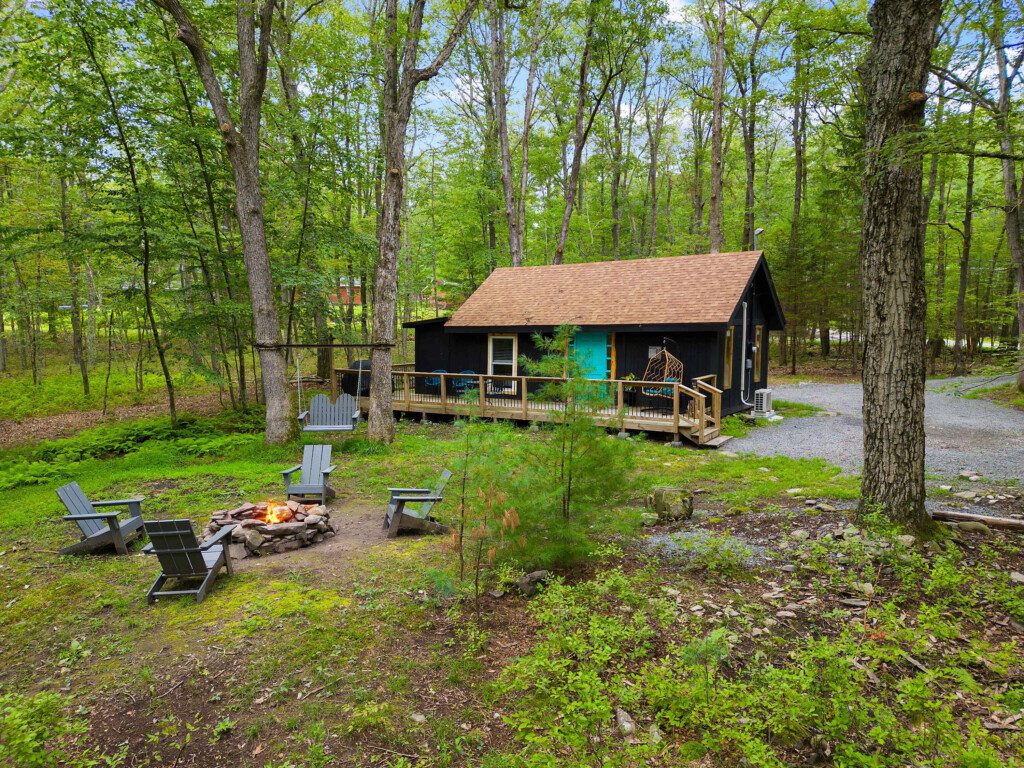This article is primarily for those looking to invest in a property in the Poconos solely for income generation in 2025. If you’re purchasing a home to use personally while occasionally renting it out, or if tax benefits are your main motivation, this may be less relevant—though it could still offer insight into rental property ownership and cash flow potential.
Additionally, this is geared toward the average investor looking at properties in the $200K–$400K range. If you’re considering higher-priced, more unique properties, the dynamics can be slightly different, potentially yielding better results.
Why Write This Article?
Because too many people are being sold a fairy tale about short-term rentals (STRs). I’ve had countless conversations with buyers who assumed their property would be cash flow positive, only to realize—too late—that the numbers just don’t add up. In many cases, I’ve had to advise owners to sell while they still can.
The reality is, someone needs to provide a realistic perspective—one that isn’t clouded by hype or best-case scenarios.
Stop Calling Them “Investment Properties”
If you’re buying a short-term rental, you’re not just investing—you’re starting a business. In my view, investing is about stocks or partial ownership of existing companies. Buying a rental property means taking on all the financial risks and operational responsibilities of building a business from the ground up. Its not much different then starting a pizza place or laundry mat.
Many buyers wrongly assume they’re purchasing a passive income stream that will be easy to manage and highly profitable. While a few properties do perform exceptionally well, the vast majority don’t.
The Reality of Small Businesses
To put things into perspective:
- 20% of small businesses fail in their first year.
- 50% fail within five years.
- The most common reasons? Cash flow issues, poor planning, and ineffective management.
Why is this relevant? Because many STR buyers underestimate the effort required to successfully operate a rental property. While social media and real estate agents often highlight success stories, the reality is that most new STR owners are struggling.
A Realistic Scenario – Jake and Sally’s First Rental Property
To illustrate this better, let’s assume the following:
- Self-Management: Some owners opt to self-manage their rentals to avoid property management fees. While this can save money upfront, our experience shows that even the best self-managed properties tend to underperform by at least 10%. In some cases, we’ve seen earnings cut in half compared to properties managed by a specialized STR property manager—not just a listing agent who simply posts on booking platforms without real expertise in pricing and market strategy.
- Gross Income Expectations: To have the best chance at profitability, we strongly recommend choosing properties that project at least 20–25% of their purchase price as annual gross revenue. For this example, we’ll use a more conservative estimate—17.66% of the purchase price—and explain why at the end.
- Competency: We’ll assume that Jake and Sally have a basic understanding of business operations and how they function, so they’ll be able to figure out some aspects of the process reasonably well.
The Beginning
Jake and Sally had been saving for years, dreaming of owning a vacation rental. After doing their research, they found what seemed like a great opportunity—a cute 3-bedroom, 2-bath home in the Poconos for $250,000. Excited about the potential for passive income, they made an offer, put 20% down ($50,000), and set aside $7,500 for closing costs, bringing their initial investment to $57,500.
But as they soon learned, buying the property was just the beginning.
The Clock Starts Ticking
On the day of closing, the reality of ownership set in. Their first mortgage payment of $1,700 was due in just 30 days. From their research, Jake and Sally knew it would take about three months before they could welcome their first guest. That meant at least two more mortgage payments ($3,400 total) before seeing a single dollar in revenue.
Even if they had bought a rental-ready property (which they hadn’t), there was still a long list of tasks to tackle before listing it online.
The Setup Phase
Legal & Administrative Work (1 Month Minimum)
- Apply for a rental permit and pass inspection
- Register with the HOA (if applicable) and pay any fees
- Obtain necessary tax certificates
These steps alone could take 30 days or more, depending on inspections, any necessary repairs, and how quickly the HOA processed applications.
Operational Setup
While waiting for paperwork, Jake and Sally had their hands full with:
- Professional photos for listings ($250)
- Setting up their listing on platforms like Airbnb and VRBO
- Pricing strategy & competition analysis
- Finding and hiring a cleaner, handyman, landscaper, etc.
Furnishing & Essential Additions
Since the house came partially furnished but needed some upgrades, they had to budget for:
- $5,000 per bedroom for additional furnishings, linens, and decor ($15,000 total for the entire interior/exterior not including hot tub)
- A hot tub, which is a requirement for competitive bookings ($7,000 including permits)
We are going to have Jake and Sally luckily finish their setup and permits in just 2 months and are able to welcome their first guest on Month 3.
Monthly Expenses While Waiting
Even before they had their first guest, there were ongoing costs:
- Mortgage payment: $1,700
- Utilities (internet, electric, etc.): $250/month for 2 months = $500
The Financial Reality: $82520 Spent Before Earning a Dime
After two months of setup, Jake and Sally had already spent $82520:
- $57,500 (down payment & closing costs)
- $15,000 (furnishings)
- $7,000 (hot tub)
- $500 (permits & fees)
- $1,700 (mortgage payments)
- $500 (utilities)
- $250 (professional photos)
- $50 (booking software)
- $20 (Pricing Software)
And this was a best-case scenario. In most cases, it takes at least three months before the first guest arrives.
The Time Commitment
Beyond the financial investment, Jake and Sally spent about 20 hours per week handling permits, setup, and logistics. Over two months, that added up to 160 hours of work—effectively four full-time workweeks without pay.
Month 3 March: First Rentals
In March, they begin renting the property and secure 3 bookings. Here’s how the numbers break down:
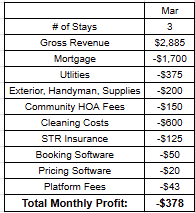
So, after accounting for all the expenses, they are operating at a loss of $378 for the third month of ownership but 1st month renting.
Months 4-8: Getting it Rolling
Over the next four months, they continue to receive bookings and start gaining traction. Since March, they’ve covered all the expenses and made a net profit of $1,362. However, by mid-August, they notice that September bookings are looking sparse— in fact, as of August 18th, they don’t have any bookings for September at all. This is because, historically, September rental rates and demand free fall off a cliff, making it a slower month for bookings.
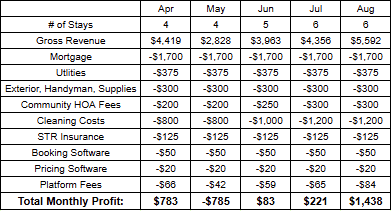
Month 9: The Reality Sets In
September proves to be one of the toughest months for many rental owners. Demand is low, and most properties either sit vacant or receive just one or two bookings throughout the entire month. For Jake and Sally, September ends with a loss of -$240, marking a difficult stretch in their rental journey.
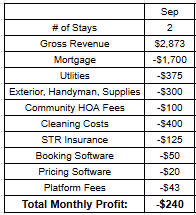
Month 10-12: The final leg
October and November are typically slow months—perhaps slightly better than September, but not by much. As you can see, the next truly profitable month isn’t until December, and that’s only if they’ve priced the holiday season correctly—something that, in our experience, many owners fail to do.

At the end of the first 12 months of owner ship this is what they are left with.
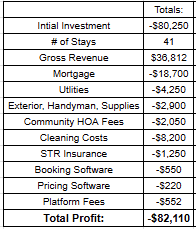
They have only managed to recoup $410 over the course of 12 months, which translates to an annual return of just 0.50% on their initial $82,520 investment—including the first two months of setup.
Now, let’s consider the time investment. We already estimated they spent 160 hours setting up the rental. Beyond that, they likely spent an average of 5 hours per week handling guest messages, clerical work, ordering supplies, making bi-weekly trips to the property, and general upkeep. Over 12 months, that adds up to 220 additional hours, bringing the total to 380 hours for the year—meaning they effectively earned $1.07 per hour for all the time they put into managing the property.
But here’s the real kicker and something I’ve left out till now—what happens if they experience a major maintenance issue? Many new rental owners assume these things won’t happen to them (Or they aren’t even aware of them), but the reality is that most properties will face at least one major repair or unexpected expense. Here are just a few common (and costly) problems:
- Appliance breakdown – Often not worth repairing, so a new one is needed: $600+
- Well pump replacement – $1,200–$1,800
- Septic pump replacement – $1,200–$1,800
- Grinder pump replacement – $4,500
- Septic Mound Leaking – $10,000
- Heating, cooling, or hot water issues – $250–$1,500
- Tree falls due to wind – $250–$1,000
- Frozen pipe bursts in winter – $500–$1,500
- Insurance-mandated roof replacement (e.g., moss growth) – $7,500
- Permit issues (e.g., unpermitted deck, too much gravel) – $500–$3,000
- High Electric or Water Bill due to an unknow issue. – $500-$2500
These expenses can and do happen, often at the worst possible time. Based on the first-year numbers, if this newly purchased rental encountered even one of these major costs, the owners would be even deeper in the red, with little to no chance of turning a profit in year one.
One thing these numbers don’t take into account is what happens when a guest cancels last minute, or when they arrive at the property and decide they don’t like it, leaving with a full refund. Or what if a snowstorm causes a power outage, or there are brush fires that drive guests away due to the smoke? (All of these have happened)
At some point while reading this, you’ve probably thought something like, “Well, it’s fine if I don’t make a profit because of the appreciation or because it’s a tax benefit.” Honestly, I have to call that out. In all my years in this business, I’ve only seen property owners genuinely consider appreciation in their decision-making once. The truth is, 99% of short-term rental owners are focused on cash flow. Yes, the property may appreciate in value, but the contents depreciate over time and need to be replaced or updated. And when owners are forced to dip into reserves—assuming they even have some—to cover costs, all those ideas about appreciation quickly fade away.
Here’s an example (just a thought experiment, not investment advice): If you took that same initial investment of $82,520 for the same type of property and invested it in the S&P 500 on January 1, 2024, by December 31, 2024, it would have grown by 23.3%. That would leave you with $101,064, a profit of $18,544—about 4423.67% more than the revenue from your short-term rental. Of course, you’d need to sell the stocks to cash out, but it would take several years—likely even more favorable ones—for this rental property to generate that kind of return. And while not every year will deliver those results, even with a 7% return, it would still outperform this short-term rental example. One other perk of stocks is you can sell them at the click of a button, you cant say the same for real estate.
Is this the reality for every property? No—not if you own a truly unique rental that stands out, like a one of ten or one of fifty kind of property. High-demand locations, exceptional design, or rare amenities can set some rentals apart. But if your property is just one of a hundred or one of a thousand in an oversaturated market, facing slow seasons, rate cuts, and vacant nights is almost inevitable.
Conclusion:
Alright, this article is getting long, so let’s wrap up with a few key points:
- A property should generate at least 20% of its purchase price in annual income to be close to profitability, with 25% being ideal.
- At a bare minimum, you need to have six months’ worth of mortgage and utilities saved up prior to purchasing, just in case rentals aren’t as busy or profitable as expected, or to cover any unexpected expenses.
- Remember, this is a business, and it could take up to five years to see a significant return on your investment or 50% of you reading this that actually buy a property will fail in the first 5 years.
- If your maximum budget for a house is $400k or less, you’re likely looking at one in a hundred, or even one in a thousand houses. At today’s prices, there are very few that will make sense on paper.
If any of these points don’t work for you, then buying a rental property in 2025 might not be the right move for you. If they do work however for you or want more information regarding rentals income potential check out our Opportunity list or our STR Tracker.

